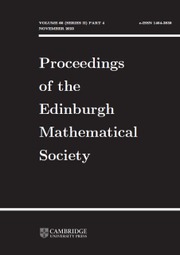No CrossRef data available.
Article contents
Strongly dense representations of surface groups
Part of:
Other groups of matrices
Published online by Cambridge University Press: 27 January 2025
Abstract
The notion of a strongly dense subgroup was introduced by Breuillard, Green, Guralnick and Tao: a subgroup Γ of a semi-simple  $\mathbb{Q}$ algebraic group
$\mathbb{Q}$ algebraic group  $\mathcal{G}$ is called strongly dense if every pair of non-commuting elements generate a Zariski dense subgroup. Amongst other things, Breuillard et al. prove that there exist strongly dense free subgroups in
$\mathcal{G}$ is called strongly dense if every pair of non-commuting elements generate a Zariski dense subgroup. Amongst other things, Breuillard et al. prove that there exist strongly dense free subgroups in  $\mathcal{G}({\mathbb{R}})$ and ask whether or not a Zariski dense subgroup of
$\mathcal{G}({\mathbb{R}})$ and ask whether or not a Zariski dense subgroup of  $\mathcal{G}(\mathbb{R})$ always contains a strongly dense free subgroup. In this paper, we answer this for many surface subgroups of
$\mathcal{G}(\mathbb{R})$ always contains a strongly dense free subgroup. In this paper, we answer this for many surface subgroups of  $\textrm{SL}(3,\mathbb{R})$.
$\textrm{SL}(3,\mathbb{R})$.
MSC classification
Information
- Type
- Research Article
- Information
- Copyright
- © The Author(s), 2025. Published by Cambridge University Press on Behalf of The Edinburgh Mathematical Society.
Footnotes
†
Both authors partially supported by the NSF
References
Alessandrini, D., Lee, G-S. and Schaffhauser, F., Hitchin components for orbifolds, J. Euv. Math. Soc. 25(4): (2023), 1285–1347.Google Scholar
Ballas, S. and Long, D. D., Constructing thin subgroups commensurable with the figure-eight knot group, Algebraic and Geometric Topology 15(5): (2015), 3009–3022.CrossRefGoogle Scholar
Breuillard, E., Green, B., Guralnick, R. and Tao, T., Strongly dense free subgroups of semisimple algebraic groups, Israel J. Math. 192(1): (2012), 347–379.CrossRefGoogle Scholar
Breuillard, E., Guralnick, R. and Larsen, M., Strongly dense free subgroups of semisimple algebraic groups II, J. Algebra 656 (2024), 143–169.CrossRefGoogle Scholar
Choi, S. and Goldman, W. M., The deformation spaces of convex  $\mathbb{RP}^2$-structures on 2-orbifolds, Amer. J. Math. 127(5): (2005), 1019–1102.CrossRefGoogle Scholar
$\mathbb{RP}^2$-structures on 2-orbifolds, Amer. J. Math. 127(5): (2005), 1019–1102.CrossRefGoogle Scholar
Goldman, W., Convex real projective structures on compact surfaces, J. Diff. Geom. 31(3): (1990), 791–845.Google Scholar
Labourie, F., Anosov flows, surface groups and curves in projective space, Invent. Math. 165(1): (2006), 51–114.CrossRefGoogle Scholar
Long, D. D. and Reid, A. W., Constructing thin groups, in Breuillard, E. and Oh, H., Thin Groups and Superstrong Approximation, Volume 61 (CUP, 2014) M. S. R. I. Publications, 151–166.CrossRefGoogle Scholar
Long, D. D., Reid, A. W. and Thistlethwaite, M., Zariski dense surface subgroups in  ${SL}(3,\mathbb{Z})$, Geometry and Topology 15(1): (2011), 1–9.CrossRefGoogle Scholar
${SL}(3,\mathbb{Z})$, Geometry and Topology 15(1): (2011), 1–9.CrossRefGoogle Scholar
Long, D. D., Reid, A. W. and Wolff, M., Most Hitchin representations are strongly dense. To appear arXiv:2202.09306, Michigan J. Math.Google Scholar


